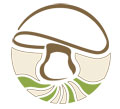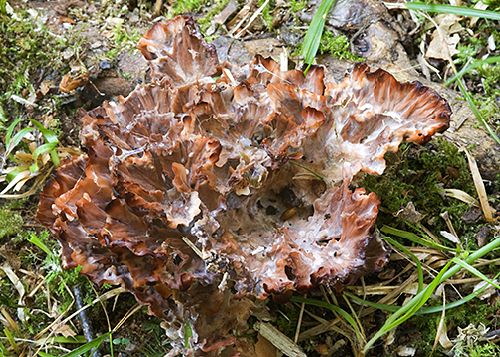Ashurst Woods
Sat 8 Oct 2011
Field event ID HF1124
OS Grid areas: SU3309
Weather: The day was warm and calm with a thin veil of pellucid cloud. The ground was dry apart from the small areas of bog towards the railway line.
Report: (Mark Jackson) The foray began with a brief reprimand from a local who was unhappy with all the cars parked on the side of the road. Sara calmed the situation very diplomatically and we were soon on our way, setting of north east into Ashurst wood towards the railway line. Within 20 seconds Tina found a small troop of chanterelle (Cantherellus cibarius) and Chris, a frightfully unattractive specimen of Lactarius turpis (ugly milkcap). Later, yet another record for Hydnellum spongiosipes (velvet tooth) was discovered by Sue Lambert. This specimen showed a very straight edge on one side of the fruiting body causing Sara to wonder if this was evidence that Alan Lucas had been wandering the woods recently, beating us to it !. We headed down towards a small bog where a fine specimen of hen of the woods (Grifola frondosa) was found by David Holt in a gap between two trunks of an oak. Lying next to this fungus was a larval web covered in eggs, that had been laid soon after emergence from the pupa by the flightless female of the vapourer moth (Orgyia antiqua). Beyond the bog under a stand of pine, a plethora of bovine bolete (Suillus bovinus) were discovered littering the woodland floor. Sara mentioned that a species of fungus known as rosy spike (Gomphidius roseus) should also be here amongst the hoards of Suillus, as it is now pretty much accepted it has an association with this species. It is thought that the latter is a parasite of the former i.e. One is never found without the other. With this in mind I set about proving this assumption correct and after about a minute of searching found an individual specimen of this ectomycorrhizal fungi. Ectomycorrhizal fungi form a sheath around the hosts roots rather than invaginating the cells of the root like endomycorrhizal fungi. As we continued the hunt for new species a light hearted disagreement had erupted between Chris and Tina as to whether the bolete they had found was Boletus luridus (lurid bolete) or B. Satanas (Devil’s bolete), it would be settled with the chosen weapon of a pen knife. The decisive cut was made and everyone stared at the cleaved halves. Part of the stipe and flesh instantly turned a vivid turquoise, Chris felt exonerated,……but only for a brief moment, until Sara exclaimed and pointed out that it was neither, as the bottom of the stipe had turned a deep crimson red, reminiscent of beetroot. The verdict was swift and very poignant as it was in fact deceiving bolete (Boletus queletii). It was decided that the foray would end early after lunch, which was taken on a large fallen beech in the presence of two young specimens of zoned rosette (Podoscypha multizonata) found by Angela Currie.
Species list: Agaricus sylvicola var. sylvicola, Amanita citrina var. citrina, Amanita excelsa var. spissa, Amanita fulva, Boletus queletii, Bulgaria inquinans, Calocera cornea, Cantharellus cibarius, Chlorociboria aeruginascens, Clitopilus prunulus, Daedaleopsis confragosa, Exidia glandulosa, Fistulina hepatica, Ganoderma australe, Gomphidius roseus, Grifola frondosa, Gymnopilus junonius, Gymnopus fusipes, Hydnellum spongiosipes, Hydnum repandum, Hymenochaete rubiginosa, Hypholoma fasciculare var. fasciculare, Ischnoderma benzoinum, Laccaria amethystina, Laccaria laccata, Lactarius quietus, Lactarius vellereus, Lycoperdon pyriforme, Parasola plicatilis, Phaeolus schweinitzii, Pholiota squarrosa, Piptoporus betulinus, Podoscypha multizonata, Postia subcaesia, Psathyrella piluliformis, Rhodocollybia butyracea, Russula caerulea, Russula claroflava, Russula fellea, Russula nobilis, Russula ochroleuca, Russula sardonia, Schizopora paradoxa, Scleroderma areolatum, Scleroderma citrinum, Stereum hirsutum, Stropharia semiglobata, Suillus bovinus, Trametes versicolor, Tricholoma fulvum, Trochila ilicina, Tylopilus felleus


